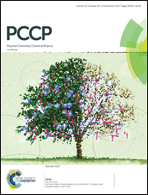Bonding and optical properties of spirocyclic-phosphazene derivatives. A DFT approach†
Abstract
The bonding properties of phosphazenes and spirocyclophosphazenes containing tris-2,2′-dioxybiphenyl groups and their derivatives were investigated by means of different computational techniques. Electronic delocalization and phosphazene–ligand bonding were studied in terms of natural bond orbitals (NBOs) and energy decomposition (EDA) analysis in combination with the natural orbital for chemical valence (NOCV), which showed the dependency of the charge transfer with the electron delocalization. TD-DFT calculations were employed to study the absorption profile of the studied molecules and to contrast the redshift and change in intensities of the λmax. An assessment of second-order stabilization energies, ΔE2, within the NBO analysis revealed clear differences between the cyclic-phosphazene arrays. The EDA-NOCV showed that the ligand-phosphazene charge transfer is stronger in phosphazene with amine substituents (4c), which is due to the donor character of the substituent over the phenyl ring. The NBO analysis confirmed either the inflow or outflow of charge due to the influence of the electron donor or electron withdrawing groups.



 Please wait while we load your content...
Please wait while we load your content...